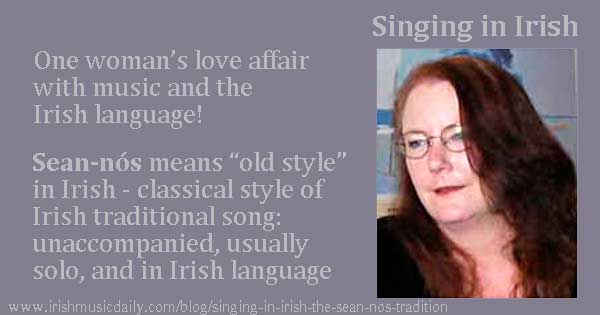
Like many Americans, I grew up with a very fixed idea of Irish traditional singing. I cut my musical teeth on The Irish Rovers, The Dubliners, and The Clancy Brothers in the 1970s, and cherished fond images of someday finding myself singing in an Irish pub, belting out rebel songs and drinking songs, accompanied by guitars, banjos, bodhráns, and tin whistles.
Then I discovered sean-nós singing.
Sean-nós (pronounced shan nohss) means “old style” in Irish. When applied to singing, it refers to the classical style of Irish traditional song: unaccompanied, usually solo, and in the Irish language.
 Singing sean-nós, however, involves more than just knowing Irish, knowing the tunes, and being comfortable singing without accompaniment. Stylistically, it’s very, very different from what most of think of as “Western Music,” and the learning process is a long one – some of the most respected sean-nós singers have 40 adult years or more in their craft! (With barely six years under my belt, I’m just starting to scratch the surface).
Singing sean-nós, however, involves more than just knowing Irish, knowing the tunes, and being comfortable singing without accompaniment. Stylistically, it’s very, very different from what most of think of as “Western Music,” and the learning process is a long one – some of the most respected sean-nós singers have 40 adult years or more in their craft! (With barely six years under my belt, I’m just starting to scratch the surface).
Some stylistic features of sean-nós singing
The tone, produced near the back of the mouth, tends to have a slightly nasal quality. Sean-nós singers also tend to close quickly to singable consonants such as “m” and “n” rather than sing on the vowels, which can create an interesting “drone” effect
Another notable feature is the lack of dynamics. In fact, ideally, there is no dynamic variation at all (which is surprisingly hard to do!). Instead, the sean-nós singer uses ornaments to highlight important passages. These can be subtle (changing the rhythm of the line slightly, for example) or quite melismatic, and will vary from verse to verse. There are regional differences as well. Singers from Donegal, for example, tend to be rather sparing of ornamentation, whereas singers from Connemara can be as richly melismatic as any opera singer.
The performance
The sean-nós singer isn’t a “performer,” per se, but a medium for the music. He or she sits or stands quietly, possibly swaying a little with the music, eyes often closed or fixed off in the distance. Whether the song is a lighthearted song of seduction (such as Cúnla or Buachaill Ón Éirne) or a heartbreaking song of loss (such as Fill, Fill, A Rún Ó or An Mhaighdean Mhara), that sense will come from the words and from the singer’s voice, not typically from his or her face or posture.
Some singers will indicate the end of a song by speaking the last few words rather than singing them, or by saying “sin é” (“that’s it”), but often the only indication that the song is done is that the singer “comes back to earth,” so to speak.
Audience etiquette
When the song begins, the gathering falls abruptly silent and remains so until the song is done, other than occasional encouraging utterances such as “maith thú” (“well done”) or “mo cheol thú” (the Irish equivalent of “bravo”). It’s considered very bad manners to join in and sing along unless the song has a repeated refrain (and even then, it’s best to avoid doing so unless you know it’s the local practice), and the height of rudeness to continue chatting while the singer is singing.
Modern adaptations
Sean-nós isn’t to everyone’s taste. To some, the bare melody – unaccompanied, and unharmonized – is too stark…too “foreign.” Many performers, including “super groups” such as Clannad and Altan, have endeavored to make these old songs more approachable to a broader audience by adding instrumentation and harmonies and arranging them in more conventional folk (or even folk-rock) settings. These arrangements have a place in our tradition as well. But I think that any Irish musician should have some exposure to the classical sean-nós tradition…the foundation of much that we find beautiful in Irish traditional music.
Oh, and in case you’re curious, I did finally realize my dream of singing in an Irish pub. But there were no guitars or bodhráns or whistles…no “small free birds” or “whack fol the daddy-o’s.” Just me, a hushed Donegal audience, and Fill, Fill, A Rún Ó. I wouldn’t have had it any other way.
Coming next week: A listener’s guide to Irish song
See the other articles on singing in Irish. Click the links below.
Part 1 “Singing in Irish: yes – it’s a language”
Part 2 “Singing In Irish — The Sean-Nós Tradition”
Part 3 “A listener’s guide to Irish song: a taste of sean-nós”
Audrey Nickel lives near Santa Cruz, California, where she studies sean-nós singing with Mary Mc Laughlin. She also plays both the wire-strung Gaelic harp and the nylon-strung Celtic harp and sings in two choirs, including the Santa Cruz-based Irish Gaelic Christmas choir, Cór Ainglí. She shares her home with her husband and teenaged daughter, an Irish-speaking black cat, a poodle who thinks he’s a sean-nós singer, four harps, and 25 tin whistles.